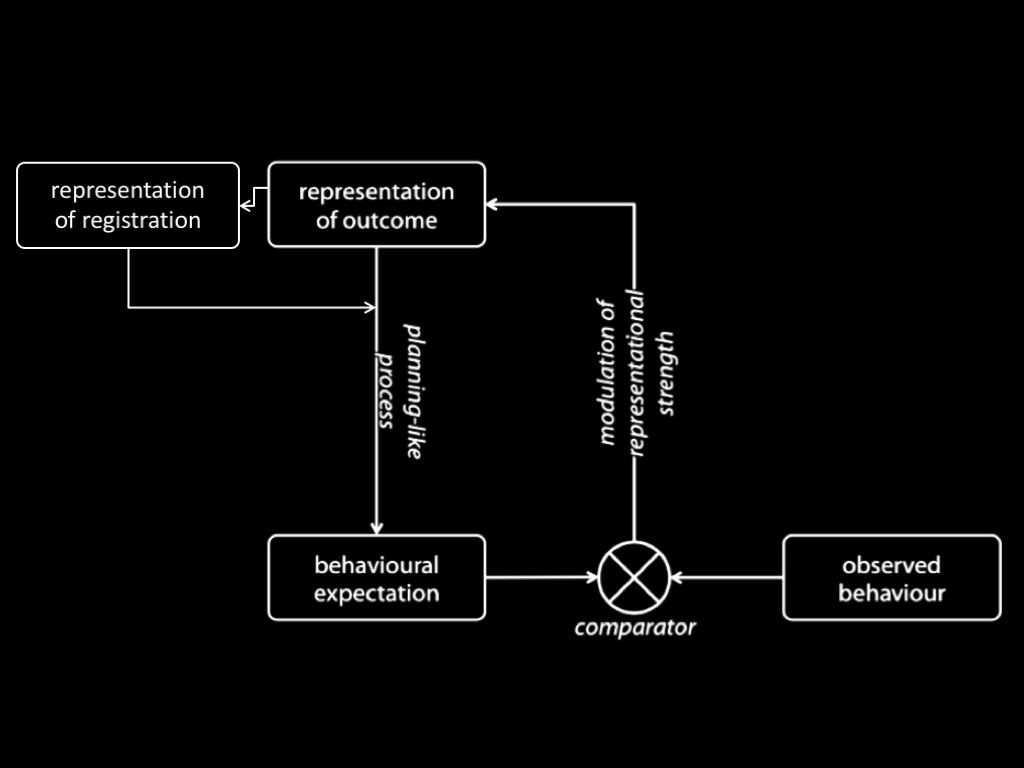The recording is from a rough rehearsal to check the timing.
Some updates to slides and script happened after that.
What Is Mirrored?
In response to Heyes’ first lecture, I want to focus on a detail:
‘Multivoxel pattern analysis has revealed that “mirror” areas including
premotor cortex encode concrete representations of observed actions (e.g.,
the action involved in opening a particular bottle) rather than abstract,
higher level representations (e.g., the goal “to open”; Wurm & Caramazza,
2019; Wurm & Lingnau, 2015).’
(Heyes & Catmur, 2022, p. 155)
How should we understand abstract vs concrete in this context?
Wurm & Lingnau (2015)’s concern is whether mirror processes are concrete or
abstract with respect to lexical action categories.
(In English, you can open many things including bottles, boxes, doors, digital files, hearts and minds.)
Their findings that motor processes are lexically concrete
are consistent with findings that some motor processes are kinematically abstract:
that is, they are concerned with goals that are distal with respect to the means-ends relation
and with the correctness of actions relative to such goals
(Naish, Houston-Price, Bremner, & Holmes, 2014; Candidi, Urgesi, Ionta, & Aglioti, 2008).
Background: The Kovács Effect
Kovács, Téglás, & Endress (2010) established that another’s irrelevant belief
can influence how quickly you can detect the presence of an object.
Despite some initial doubts (Phillips et al., 2015),
this finding has been widely replicated by several labs
(including Wel, Sebanz, & Knoblich, 2014; Edwards & Low, 2017; El Kaddouri, Bardi, De Bremaeker, Brass, & Wiersema, 2020).
Question
Why do others’ false beliefs ever have an effect on your own actions?
The Model

Predictions of the Model
-
In motor mindreading only, goal-tracking will manifest sensitivity to agents’ beliefs.
-
In motor mindreading only, physically constraining protagonists or participants will impair belief tracking.
This talk concerns the second prediction only.
Findings So Far
Low, Edwards, & Butterfill (2020) support the prediction: physically constraining a protagonist did impair belief tracking.
Six (2022, p. Experiment 2) did not support the prediction: physically constraining participants
did not impair their belief tracking.
And the results from a study in preparation that builds on Zani, Butterfill, & Low (2020)’s balance paradigm
found only suggestive evidence for the prediction.
Candidi, M., Maria Sacheli, L., Mega, I., & Aglioti, S. M. (2014). Somatotopic Mapping of Piano Fingering Errors in Sensorimotor Experts: TMS Studies in Pianists and Visually Trained Musically Naïves.
Cerebral Cortex,
24(2), 435–443.
https://doi.org/10.1093/cercor/bhs325Candidi, M., Urgesi, C., Ionta, S., & Aglioti, S. M. (2008). Virtual lesion of ventral premotor cortex impairs visual perception of biomechanically possible but not impossible actions.
Social Neuroscience,
3(3–4), 388–400.
https://doi.org/10.1080/17470910701676269Cattaneo, L., Sandrini, M., & Schwarzbach, J. (2010). State-Dependent TMS reveals a hierarchical representation of observed acts in the temporal, parietal, and premotor cortices.
Cerebral Cortex,
20(9), 2252–2258.
https://doi.org/10.1093/cercor/bhp291Cretu, A. L., Ruddy, K., Germann, M., & Wenderoth, N. (2019). Uncertainty in contextual and kinematic cues jointly modulates motor resonance in primary motor cortex.
Journal of Neurophysiology,
121(4), 1451–1464.
https://doi.org/10.1152/jn.00655.2018Edwards, K., & Low, J. (2017). Reaction time profiles of adults’ action prediction reveal two mindreading systems.
Cognition,
160, 1–16.
https://doi.org/10.1016/j.cognition.2016.12.004El Kaddouri, R., Bardi, L., De Bremaeker, D., Brass, M., & Wiersema, J. R. (2020). Measuring spontaneous mentalizing with a ball detection task: Putting the attention-check hypothesis by Phillips and colleagues (2015) to the test.
Psychological Research,
84(x), 1749–1757.
https://doi.org/10.1007/s00426-019-01181-7Heyes, C. M., & Catmur, C. (2022). What Happened to Mirror Neurons?
Perspectives on Psychological Science,
17(1), 153–168.
https://doi.org/10.1177/1745691621990638Kovács, Á. M., Téglás, E., & Endress, A. D. (2010). The social sense: Susceptibility to others’ beliefs in human infants and adults.
Science,
330(6012), 1830–1834.
https://doi.org/10.1126/science.1190792Low, J., Edwards, K., & Butterfill, S. A. (2020). Visibly constraining an agent modulates observers’ automatic false-belief tracking.
Scientific Reports,
10(1), 11311.
https://doi.org/10.1038/s41598-020-68240-7Naish, K. R., Houston-Price, C., Bremner, A. J., & Holmes, N. P. (2014). Effects of action observation on corticospinal excitability: Muscle specificity, direction, and timing of the mirror response.
Neuropsychologia,
64, 331–348.
https://doi.org/10.1016/j.neuropsychologia.2014.09.034Phillips, J., Ong, D. C., Surtees, A. D. R., Xin, Y., Williams, S., Saxe, R., & Frank, M. C. (2015). A Second Look at Automatic Theory of Mind: Reconsidering Kovács, Téglás, and Endress (2010).
Psychological Science,
26(9), 1353–1367.
https://doi.org/10.1177/0956797614558717Rizzolatti, G., & Sinigaglia, C. (2016). The mirror mechanism: A basic principle of brain function.
Nature Reviews Neuroscience,
advance online publication.
https://doi.org/10.1038/nrn.2016.135Sinigaglia, C., Quarona, D., Riva, G., & Butterfill, S. A. (2021). Seeing ain‘t believing: How we read other minds.
In Preparation,
x(x).
Six, P. (2022).
Observing Action in Uncertainty: The Role of Belief-tracking in Action Observation (Thesis). Te Herenga Waka-Victoria University of Wellington.
https://doi.org/10.26686/wgtn.19669581Villiger, M., Chandrasekharan, S., & Welsh, T. N. (2010). Activity of human motor system during action observation is modulated by object presence.
Experimental Brain Research,
209, 85–93.
https://doi.org/10.1007/s00221-010-2522-xWel, R. P. R. D. van der, Sebanz, N., & Knoblich, G. (2014). Do people automatically track others’ beliefs? Evidence from a continuous measure.
Cognition,
130(1), 128–133.
https://doi.org/10.1016/j.cognition.2013.10.004Wurm, M. F., & Caramazza, A. (2019). Distinct roles of temporal and frontoparietal cortex in representing actions across vision and language.
Nature Communications,
10(1), 289.
https://doi.org/10.1038/s41467-018-08084-yWurm, M. F., & Lingnau, A. (2015). Decoding Actions at Different Levels of Abstraction.
Journal of Neuroscience,
35(20), 7727–7735.
https://doi.org/10.1523/JNEUROSCI.0188-15.2015Zani, G., Butterfill, S. A., & Low, J. (2020). Mindreading in the balance: Adults’ mediolateral leaning and anticipatory looking foretell others’ action preparation in a false-belief interactive task.
Royal Society Open Science,
7(1), 191167.
https://doi.org/10.1098/rsos.191167
